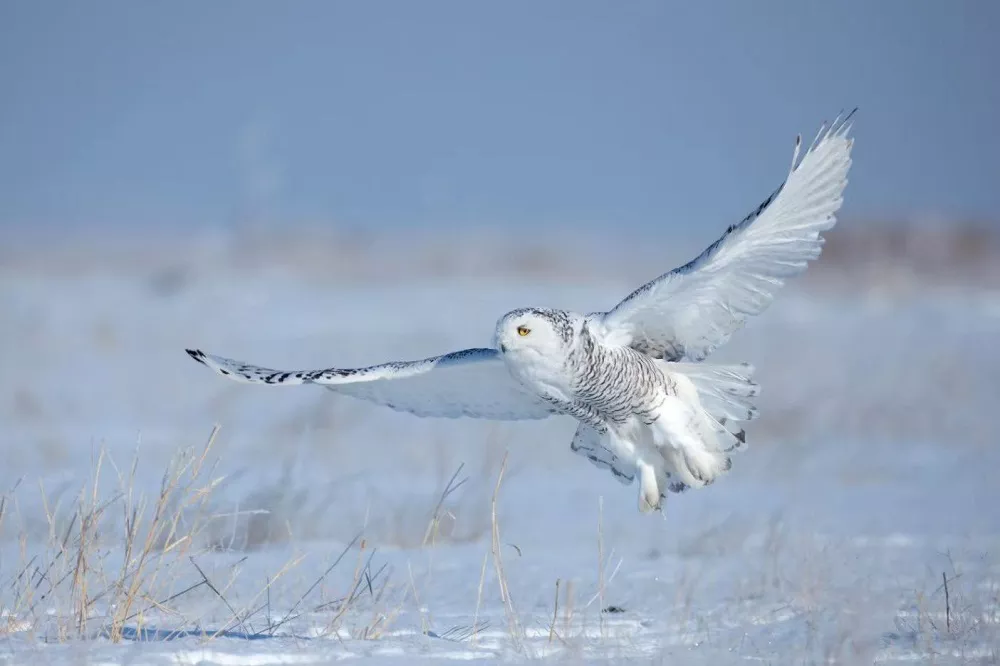The Snowy Owl (Bubo scandiacus), with its striking white plumage and piercing yellow eyes, is a magnificent bird of prey that captures the imagination of bird enthusiasts and nature lovers around the world. These majestic owls inhabit the Arctic regions of North America, Europe, and Asia, where they endure harsh environments and display incredible adaptations to survive. One aspect that fascinates researchers and enthusiasts alike is the lifespan of the Snowy Owl. In this article, we will explore the factors that influence the lifespan of Snowy Owls, their average lifespan, and the remarkable adaptations that contribute to their longevity.
An Overview of Snowy Owls:
Snowy Owls are large owls, known as the heaviest owl species in North America. Females are typically larger than males, with a wingspan that can reach up to five feet (152 cm) and a weight ranging from 3.5 to 6.6 pounds (1.6 to 3 kg). These majestic birds are well adapted to their Arctic habitats, featuring dense feathering and a thick layer of down that insulates them from the frigid temperatures.
Average Lifespan of Snowy Owls:
Snowy Owls have the potential for a relatively long lifespan compared to many other bird species. In the wild, the average lifespan of Snowy Owls is around 9 to 10 years. However, several factors can influence their lifespan, resulting in variations in individual longevity.
Factors Influencing Snowy Owl Lifespan:
- Predation
Predation is a significant factor that can impact the lifespan of Snowy Owls. While adult Snowy Owls have few natural predators due to their large size and formidable presence, young owls are more vulnerable. Arctic foxes and other raptors, such as the Golden Eagle, have been known to prey on Snowy Owl nestlings and juveniles, reducing their chances of survival.
- Environmental Conditions
Snowy Owls face challenging environmental conditions in their Arctic habitats. Severe weather events, including blizzards and storms, can impact their survival, especially during the winter months when food sources may become scarce. The availability of prey, such as lemmings and other small mammals, directly influences their ability to find sustenance and can affect their overall health and longevity.
- Reproductive Success
Reproductive success is crucial for the survival and population growth of Snowy Owls. Successful breeding pairs raise offspring that contribute to the next generation. Factors such as suitable nesting sites, the availability of prey for both parents and offspring, and the ability to defend territories play a significant role in their reproductive success. Owls that successfully reproduce may have a higher chance of passing on their genes and extending their lineage.
- Human Interference
Human activities can have both positive and negative impacts on Snowy Owl populations. On one hand, conservation efforts and habitat protection contribute to the longevity of Snowy Owls. However, human disturbance, such as habitat destruction, encroachment, and disturbance near nesting sites, can disrupt their natural behaviors and lead to stress or abandonment of nesting areas. Additionally, collisions with vehicles and power lines pose threats to Snowy Owls, potentially reducing their lifespan.
Adaptations for Longevity:
Snowy Owls have developed several adaptations that contribute to their longevity and survival in Arctic environments:
- Efficient Metabolism
Snowy Owls possess a unique ability to adjust their metabolic rate to conserve energy during periods of food scarcity. This adaptability allows them to endure extended periods without food, particularly during the winter months when prey availability is limited.
- Camouflage and Stealth
The Snowy Owl’s stunning white plumage serves as excellent camouflage in their snowy habitats, helping them blend into the landscape and avoid detection by predators and prey alike. This camouflage enables them to hunt efficiently and increases their chances of survival.
- Excellent Hunters
Snowy Owls are skilled hunters with remarkable vision and hearing capabilities. Their keen eyesight allows them to spot prey from a distance, even in low-light conditions. They rely on their acute hearing to detect small mammals scurrying beneath the snow, and their powerful talons and beaks help them capture and kill their prey effectively.
Conclusion:
Snowy Owls are remarkable creatures that thrive in the extreme conditions of the Arctic. While the average lifespan of Snowy Owls in the wild ranges from 9 to 10 years, various factors can influence their longevity, including predation, environmental conditions, reproductive success, and human interference. These majestic birds have evolved remarkable adaptations to survive in their Arctic habitats, including efficient metabolism, camouflage, and exceptional hunting abilities. Understanding the factors that impact the lifespan of Snowy Owls is crucial for their conservation and underscores the need to protect their habitats and minimize human disturbances. By appreciating the unique beauty and adaptations of Snowy Owls, we can ensure their continued presence and contribute to their long-term survival.


 Facebook
Facebook  Instagram
Instagram  Youtube
Youtube 